
|
Time-resolved soft x-ray absorption setup using multi-bunch operation modes at synchrotrons; Review of Scientific Instruments 2011 Attach:paper.pdf Time Resolved XAS experiments at the BACH beamline of ELETTRA While conventional users exploit synchrotron radiation (SR) as a very intense quasi-continuous light source, laser-pump SR-probe experiments require to operate the storage ring in unconventional modes , i.e. single-bunch, few-bunches, or hybrid modes. To overcome this limitation and to operate at variable repetition rate, the use of the multi-bunch filling pattern of the storage rings must be implemented with novel and effective acquisition concepts and ideas for performing time-resolved experiments in the sub-ns time domain. The photon counting approach to measure the fluorescence yield used in the present setup takes full advantage of the multi-bunch filling pattern of the storage ring allowing to fully exploit the photon flux of the x-ray probe and to implement a stroboscopic probing time-sequence. This schema allows snapshots of the excited transient state structures. 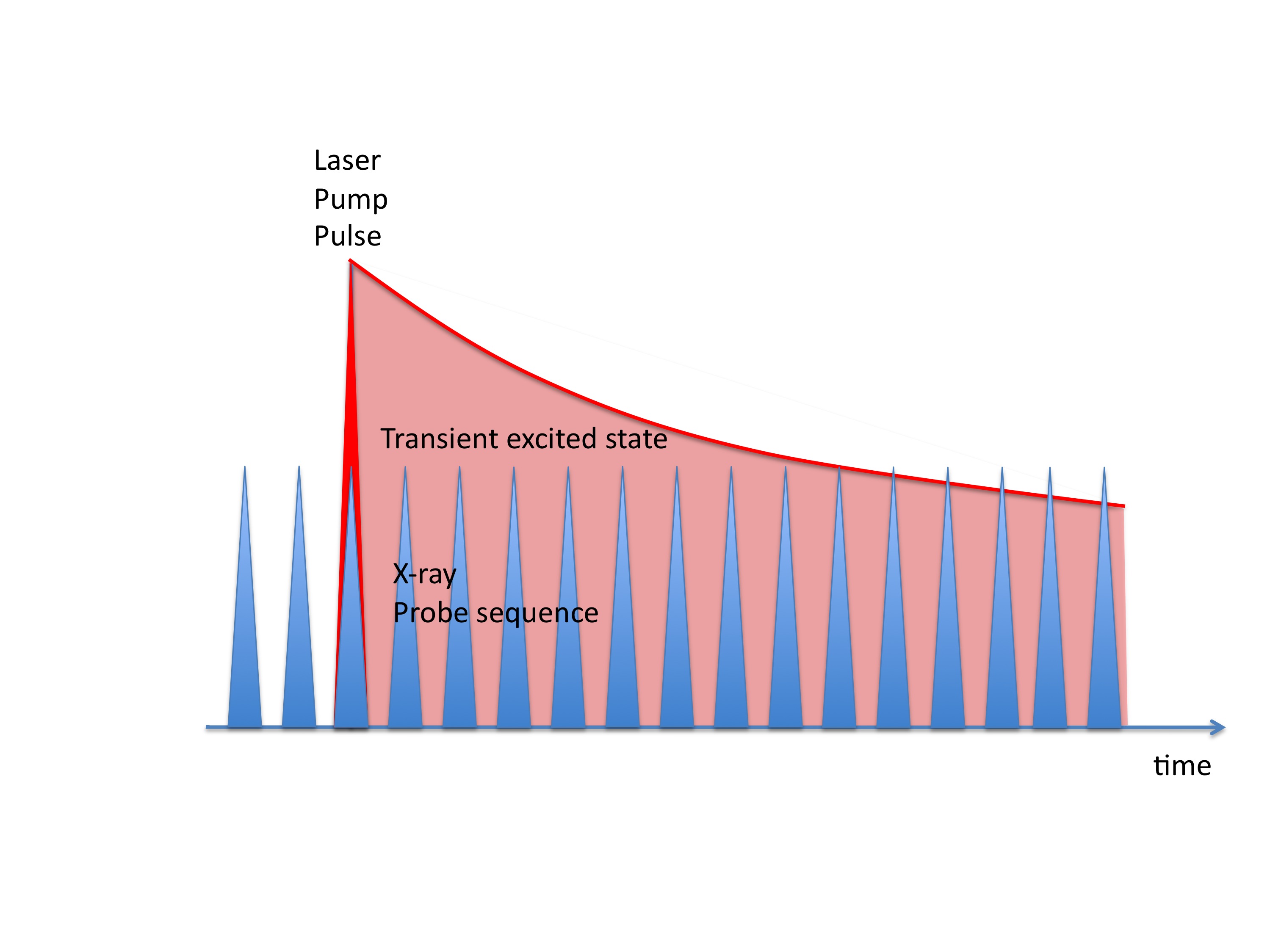 FIG. 1: Probing time sequence: the laser pump pulse triggers the excited state of the system and the synchronized series of x-ray pulses takes snapshots of the transient excited state of the electronic and atomic structure.
The present tr-XAS experimental apparatus operating at the BACH beamline allows to perform effective time-resolved soft x-ray absorption spectroscopy (XAS) in the sub-ns time scale using the synchrotron radiation generated in a non-hybrid full multi-bunch mode. The present setup is based on a variable repetition rate Ti:sapphire laser system synchronized with the ∼ 500 MHz synchrotron x-ray beam time structure (probe pulses). The synchronization is maintained through a timing unit that controls and tunes the relative time delay between the pump laser pulse and the probe x-ray pulses. A measuring unit discriminates and singles out the x-ray photon bunches by means of a photon counting system.
The synchrotron x-ray photon beam inherits the time structure of the electron bunches. The repetition rate of probing flashes results from the timing parameters and the operation mode of the storage ring. Typically, the Elettra filling mode is multi-bunch, i.e. 432 with 60 ps full-width-half-maximum (FWHM) bunches rotating in the storage ring with 2 ns interbunch period.
A regenerative amplifier system providing 5 μJ/pulse at a repetition rate of 231.4 KHz or alternatively a Mira HP Ti:Sa oscillator with a pulse-picker for 25 nJ/pulse with a repetition rate that is configurable from 83.3 MHz down to 1 MHz are used
The samples are positioned in an ultra-high vacuum chamber (experimental station B). The laser beam enters the experimental chamber through a quartz window with an angle of 30◦ with respect to the x-ray photon beam. Another window allows viewing the sample by a video camera in order to spatially overlap the laser and SR beams. The sample is mounted on 5-degrees freedom manipulator with remote controlled z translation and θ, φ rotations. The x-ray detector is set 60◦ off with respect to the x-ray photon beam and at a variable distance from the sample to perform fluorescence yield signal measurements. 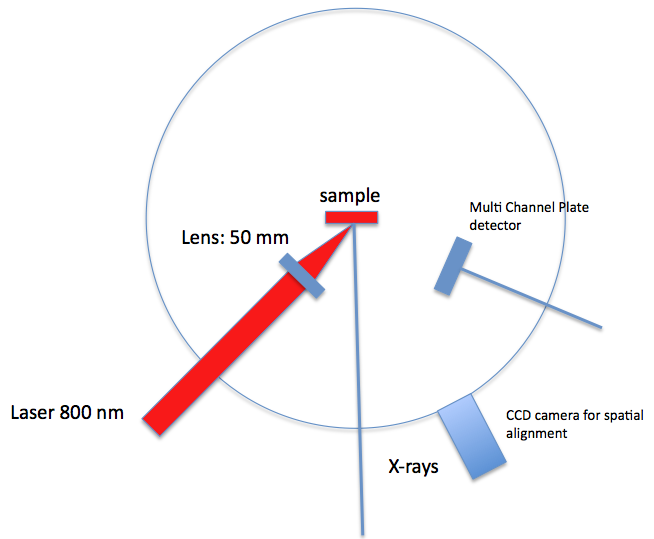 Figure 3:
The tr-XAS experiments are carried out by measuring the x-ray fluorescence yield from the sample using a custom-made detection, measurement and synchronization system. Thanks to this device time-resolved pump- probe experiments can be easily performed for the timing unit allows a very high precision synchronization and a reduced step delay shift between the laser-pump and SR- probe pulses. Moreover, the multi-bunch filling mode (providing a train of probe pulses separated by ∼ 2 ns, rather than a single probe pulse) along with the present multihit acquisition electronics, allows obtaining an effective time scan up to several hundreds of ns.
Exploiting the multi-bunch synchrotron filling mode and with a resulting essential improvement over the conven- tional pump-probe scheme, a set of ∼ 432 time-resolved spectra with 2 ns delay shift is obtained at once. The combination of multiple energy scans with a simultane- ous phase scan allows to furthermore reduce the sampling step of the time base in the time-resolved set of spectra.
As a proof of principle of our tr-XAS setup, the first time-resolved soft XAS spectra of the laser induced solid- liquid-solid transitions of crystalline germanium are shown in the following figures:
People Laser support |

 | Figure 2: A timing diagram for a pump/probe XAS measurement is shown along with a schematic layout of the experimental setup. The laser trigger is synchronized to the storage ring master RF clock with a pump/probe jitter of less than 2 ps. A commercial Ti:sapphire laser generates sub-50 fs pulses at 800 nm. Nonlinear harmonic generation processes are used to generate pump pulses of the desired wavelength (in this case second harmonic generation).
| Figure 2: A timing diagram for a pump/probe XAS measurement is shown along with a schematic layout of the experimental setup. The laser trigger is synchronized to the storage ring master RF clock with a pump/probe jitter of less than 2 ps. A commercial Ti:sapphire laser generates sub-50 fs pulses at 800 nm. Nonlinear harmonic generation processes are used to generate pump pulses of the desired wavelength (in this case second harmonic generation).
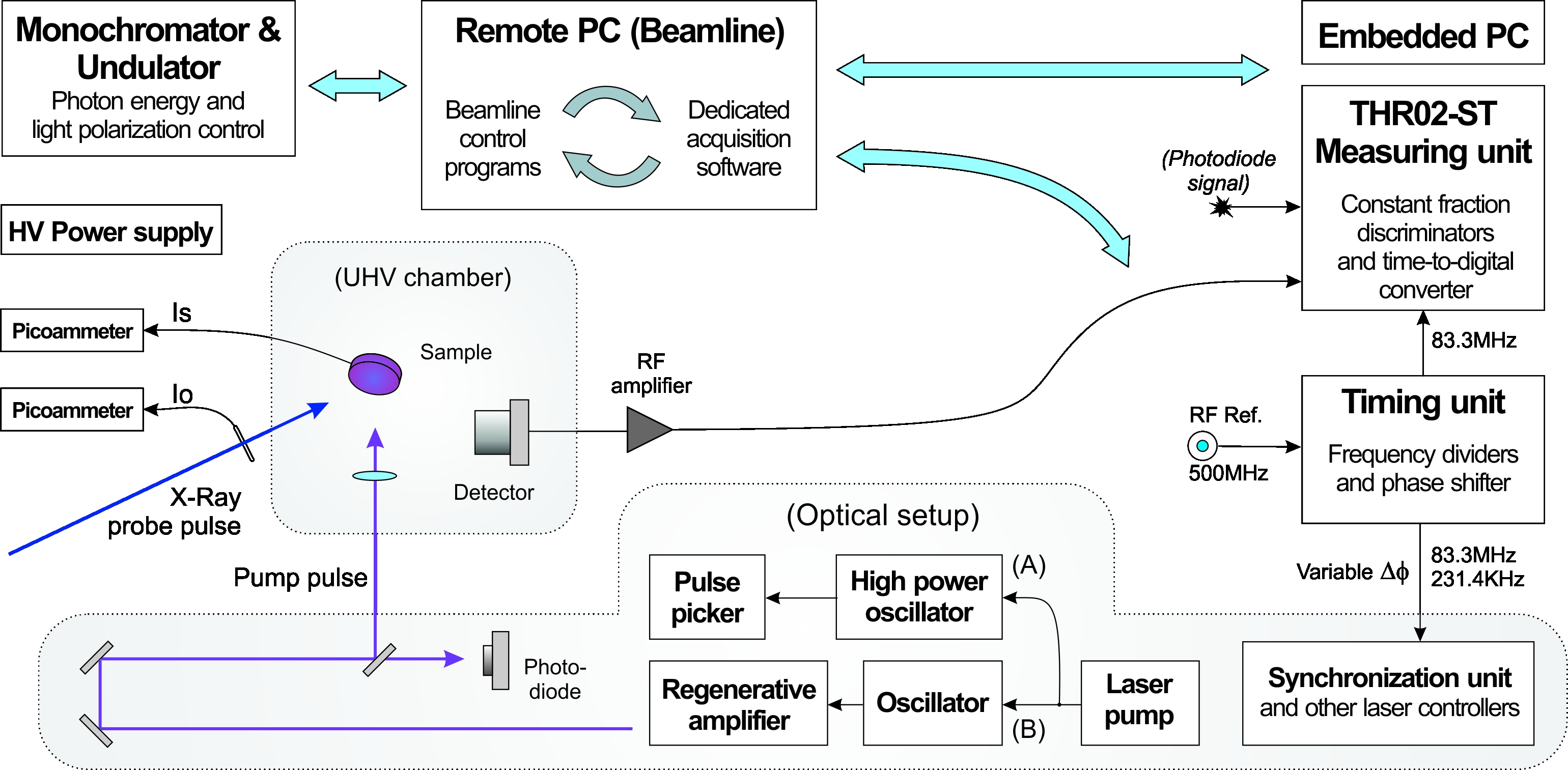
 | Figure 5: Figure 5a shows consecutive Ge L3 XAS spectra separated by a delay time of 2 ns with fixed laser-pulse SR-pulse relative delay time. Figure 5b shows cnsecutive XAS spectra taken under the same conditions of figure 5a but shifting the laser-pulse SR-pulse relative rime delay.
| Figure 5: Figure 5a shows consecutive Ge L3 XAS spectra separated by a delay time of 2 ns with fixed laser-pulse SR-pulse relative delay time. Figure 5b shows cnsecutive XAS spectra taken under the same conditions of figure 5a but shifting the laser-pulse SR-pulse relative rime delay.
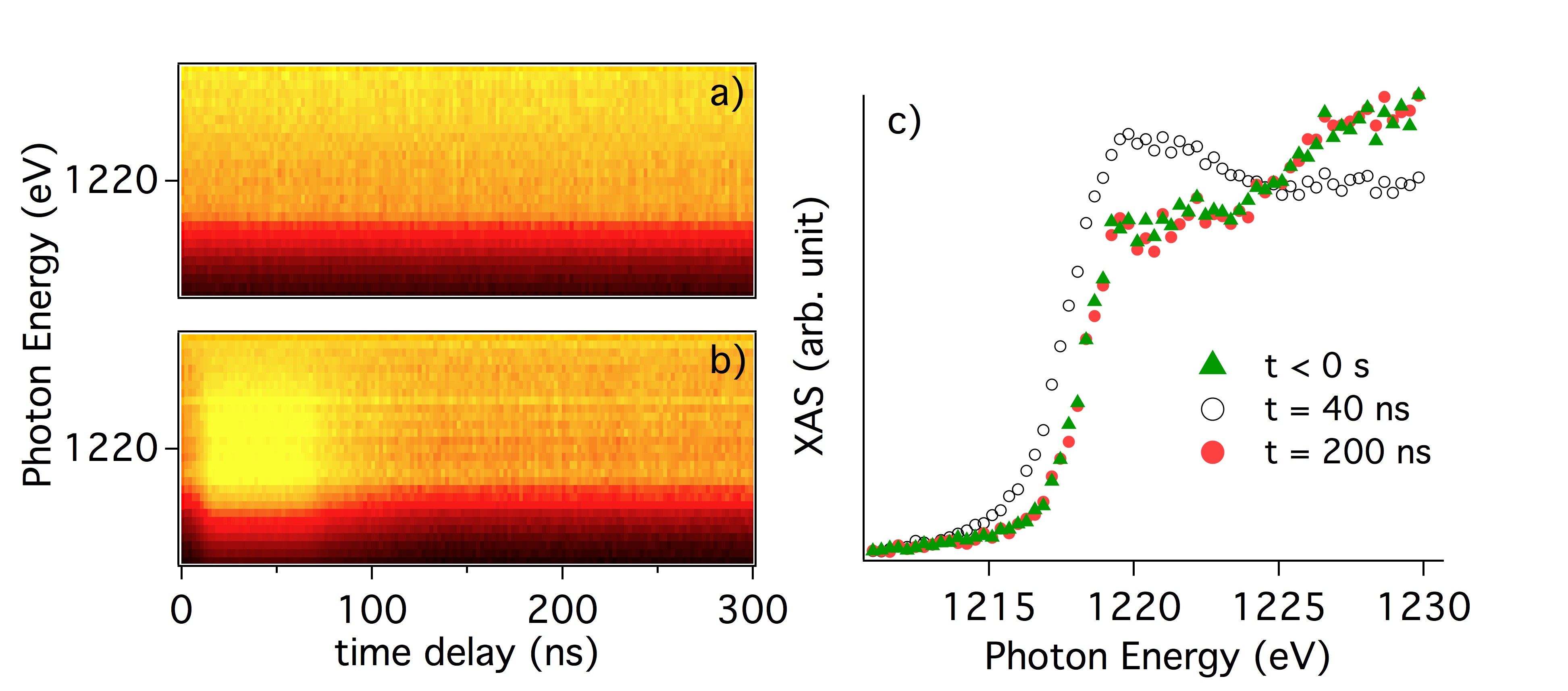 | Figure 6: Time resolved XAS spectra of the Ge L3 edge with incident laser fluence of 110 mJ/cm2 (figure 6a) and of 120 mJ/cm2 (figure 6b) . XAS spectra are plotted vs the time delay respect to the arrival time of the laser pulse (t=0) and vs the x-ray photon energy. Figure 6c: time resolved XAS spectra of the Ge L3 edge at t < 0 ns before (triangle), 40 ns (open dots) and 200 ns (closed dots) after the laser pulse.
| Figure 6: Time resolved XAS spectra of the Ge L3 edge with incident laser fluence of 110 mJ/cm2 (figure 6a) and of 120 mJ/cm2 (figure 6b) . XAS spectra are plotted vs the time delay respect to the arrival time of the laser pulse (t=0) and vs the x-ray photon energy. Figure 6c: time resolved XAS spectra of the Ge L3 edge at t < 0 ns before (triangle), 40 ns (open dots) and 200 ns (closed dots) after the laser pulse.
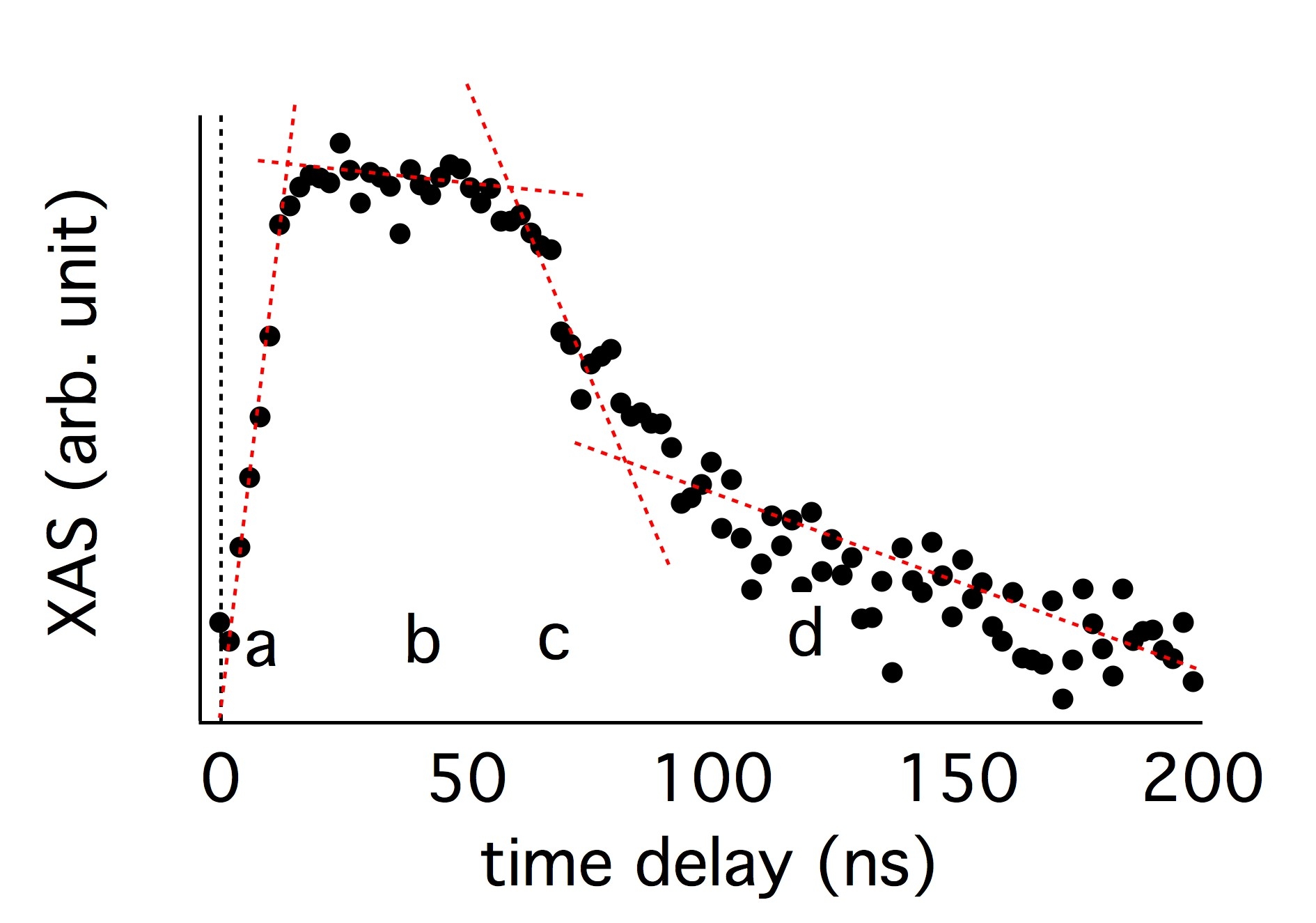 | Figure 7: The time resolved XAS relative intensity variation (photon energy 1219 eV) as a function of time can be divided into four regions according to its slope.
| Figure 7: The time resolved XAS relative intensity variation (photon energy 1219 eV) as a function of time can be divided into four regions according to its slope.